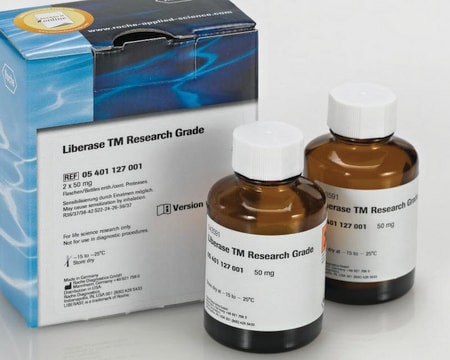04536282001
Roche
DNase I recombinant
grade I, from bovine pancreas, expressed in Pichia pastoris
About This Item
Produits recommandés
Source biologique
bovine pancreas
Niveau de qualité
Produit recombinant
expressed in Pichia pastoris
Forme
lyophilized
Activité spécifique
(>10,000 U/bottle according to Kunitz (+25°C; DNA as substrate).)
Poids mol.
39 kDa
Conditionnement
pkg of 2 × 10,000 U
Fabricant/nom de marque
Roche
Concentration
≥70-90%
Technique(s)
protein extraction: suitable
Couleur
white to light yellow
Solubilité
water: soluble
Adéquation
suitable for molecular biology
Numéro d'accès NCBI
Numéro d'accès UniProt
Application(s)
sample preparation
Activité étrangère
Proteases, none detected
RNase, none detected
Température de stockage
2-8°C
Informations sur le gène
bovine ... DNASE1(282217)
Description générale
Activity: 10,000U/bottle according to Kunitz (+25°C; DNA as substrate).
Unit definition: One unit is the enzyme activity that causes an increase in the absorbance of 0.001 per minutes under assay conditions.
Application
- DNase I, recombinant, grade I is used for:Eliminating DNA during protein isolation procedures
- Analysis of chromatin structure
- Eliminating DNA during sample preparation
Caractéristiques et avantages
Lyophilizate
Définition de l'unité
Assay mixture: Calf thymus DNA (100 μg) is incubated with 20 to 50 U DNase I at +25 °C.
The increase in absorbance is measured at 260 nm.
Information Note: These conditions are used for the determination of activity,according to Kunitz, since the Kunitz assay results in high reproducibility and sensitivity. When using this enzyme for normal experimental purposes, Roche recommends using incubation buffers that are appropriate for a given application, e.g., as mentioned in the standard literature (Sambrook et al., Curr. Prot. Mol. Biol., etc.).
Notes préparatoires
Storage conditions (working solution): Long-term Storage of the Dissolved Enzyme
The solvent generally recommended for DNase I is water. When DNase I is reconstituted in water, the solution can be kept for 2 days at 2 to 8 °C and for 1 month at -15 to -20 °C. For best results, prepare appropriate aliquots and avoid repeated freezing and thawing. However, for long-term storage, carefully dissolve DNase I in one of the buffers listed below. In buffer 1, the enzyme will be stable for several weeks. The enzyme will be stable for at least 18 months if it is dissolved in buffer 2, 3, or 4 and stored at the recommended temperatures.
Information note: Do not vortex the enzyme while dissolving!
Buffer 1: 20 mM Tris-HCl, 20 mM MgCl2, 5 mM CaCl2, 0.1 mM dithioerythritol, 0.1 mM EDTA, 50% (v/v) glycerol, pH 8. Store this solution at -15 to-25 °C; it will not freeze at this temperature and will be stable for several weeks.
Buffer 2: 20 mM Tris-HCl, 50 mM NaCl, 1 mM dithioerythritol, 100 μg/mL BSA, 50% glycerol (v/v), pH 7.6. Store this solution at -15 to -25 °C for up to 18 months; it will not freeze at this temperature.
Buffer 3: 20 mM Tris-HCl, 1 mM MgCl2, 50% (w/v) glycerol, pH 7.5. Store this solution at -15 to -25 °C for up to 18 months; it will not freeze at this temperature.
Buffer 4: 20 mM Tris-HCl, 1 mM MgCl2, pH 7.5. Aliquot in appropriate amounts (e.g., 10 μl), freeze the aliquots quickly on dry ice, and store at -60 °C or below for up to 18 months. Thaw only the amount needed for each experiment. Do not refreeze. Discard any leftover thawed solution.
Stockage et stabilité
Autres remarques
Mention d'avertissement
Danger
Mentions de danger
Conseils de prudence
Classification des risques
Resp. Sens. 1 - Skin Sens. 1
Code de la classe de stockage
11 - Combustible Solids
Classe de danger pour l'eau (WGK)
WGK 1
Point d'éclair (°F)
does not flash
Point d'éclair (°C)
does not flash
Certificats d'analyse (COA)
Recherchez un Certificats d'analyse (COA) en saisissant le numéro de lot du produit. Les numéros de lot figurent sur l'étiquette du produit après les mots "Lot" ou "Batch".
Déjà en possession de ce produit ?
Retrouvez la documentation relative aux produits que vous avez récemment achetés dans la Bibliothèque de documents.
Les clients ont également consulté
Notre équipe de scientifiques dispose d'une expérience dans tous les secteurs de la recherche, notamment en sciences de la vie, science des matériaux, synthèse chimique, chromatographie, analyse et dans de nombreux autres domaines..
Contacter notre Service technique











